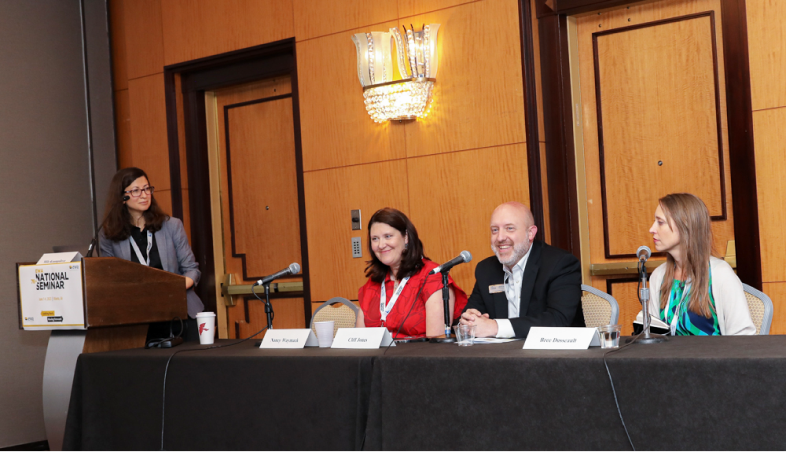
What Will Academic Recovery Post-ESSER Look Like?
The deadline for school districts to spend ESSER funds is quickly approaching. Here’s some expert insight.
Photo credits: Allison Shelley for EDUimages; Jimmy Minichello of AASA

The deadline for school districts to spend ESSER funds is quickly approaching. Here’s some expert insight.
Photo credits: Allison Shelley for EDUimages; Jimmy Minichello of AASA
There’s no question that disruption from the COVID-19 pandemic took a toll on students and learning.
Since then, school districts across the country have taken measures to help students recover from disrupted learning – including tutoring programs and special hiring decisions – fueled in part by federal pandemic-relief funds, or Elementary and Secondary School Emergency Relief (ESSER) Funds.
The deadlines for committing the funds for the remaining allocations of money – ESSER I in September 2022, ESSER II in September 2023 and ESSER III in September 2024 – are upon us, but questions remain about how funds have been spent, what is working and what comes next.
Several speakers shared their thoughts on this topic at the Education Writers Association’s 2023 National Seminar: Bree Dusseault, principal and managing director of the Center on Reinventing Public Education; Cliff Jones, chief academic officer of Fulton County Schools (Georgia), and Nancy Waymack, the director of research partnerships and policy for the National Student Support Accelerator. Mila Koumpilova of Chalkbeat Chicago served as moderator.
Here are some key takeaways:

For the first two years of the pandemic, the Center on Reinventing Public Education tracked 100 large school districts every week, keeping tabs on spending plans and how they evolved over time.
Most districts said they planned to use money for one-time investments, such as facility and technology upgrades; social and emotional learning and mental health; extended learning and tutoring, Dusseault said. Less than 30% of these districts planned to use funds for teacher, staff or parent support.
It’s much more complicated to track actual expenditures – which are often buried in budgets – but anecdotal evidence seems to show that districts have been spending on high-dosage tutoring, extended learning opportunities – such as summer school or longer days – and curriculum shifts, such as science of reading, Dusseault said.
But spending varies widely by state, Dusseault said.
Some had plans ready to go the moment American Recovery Plan ESSER funds were released, and others may have less direction. For example, Ohio announced a $20 million high-dosage tutoring program and access to virtual tutoring for students with Individualized Education Programs, and wrote legislation to ensure science of reading was widely used throughout the state.
To complicate things further, only some states have tracked the effectiveness of spending measures.
“It’s hard to tell what is truly working or not, and it’s harder to tell that across regions or states,” Dusseault said.
But there are exceptions.
Connecticut set up a collaborative between state universities and districts, which tracked success in a home-visit tutoring program. Similar efforts exist in North Carolina: Guilford County allocated nearly $10 million of its ESSER funds to create learning hubs that targeted students at risk of dropping out or not graduating. When partnered with high-dosage tutoring, this approach improved graduation rates, Dusseault said.
Fulton County Schools, the fourth largest school system in Georgia, worked with the Metro Atlanta Policy Lab for Education (MAPLE) from the beginning to help track what worked, Cliff Jones said.
The district refers to the pandemic’s effects on students as “learning disruption” rather than “learning loss” because of emotional impacts.
Additionally, the district used federal funds to work on learning acceleration, namely high-dosage, small-group tutoring, with 90,000 students and 18 schools. Students met three times a week in a four-to-one ratio with a tutor for 30 minutes outside regular learning.
“But the money’s running out, and what’s next, what’s sustainable is kind of the question for us,” Jones said.
High-dosage tutoring is embraced by districts across the country because research has shown it works, Nancy Waymack said.
In 2020, even before ESSER funding, the U.S. spent $40 billion on tutoring a year, Waymack said.
“It’s something we do by instinct … families of means have hired tutors for their students for years and years,” Waymack said.
National Student Support Accelerator found that ESSER funding was a facilitator for tutoring, and districts used the money to bring in additional tutors through contracts or partnerships, Waymack said.
However, Waymack said some districts have had challenges staffing the tutoring programs, fitting it into the school day and making sure students attend school to get access to the tutoring.
Fulton County is tracking what’s working – for example, math is recovering more slowly than English Language Arts for many students – to help its leaders decide what to keep after ESSER funds run out, according to Jones.
“Education is not a single thread,” he said. “You have a tapestry of support for kids, and you start pulling out different pieces whether it be the small-group tutoring, or you go back to increasing class size.”
Resources are finite, he said, so focusing on one area of recovery might mean another will receive less support.
“It has to be very purposeful,” he added.
Your post will be on the website shortly.
We will get back to you shortly